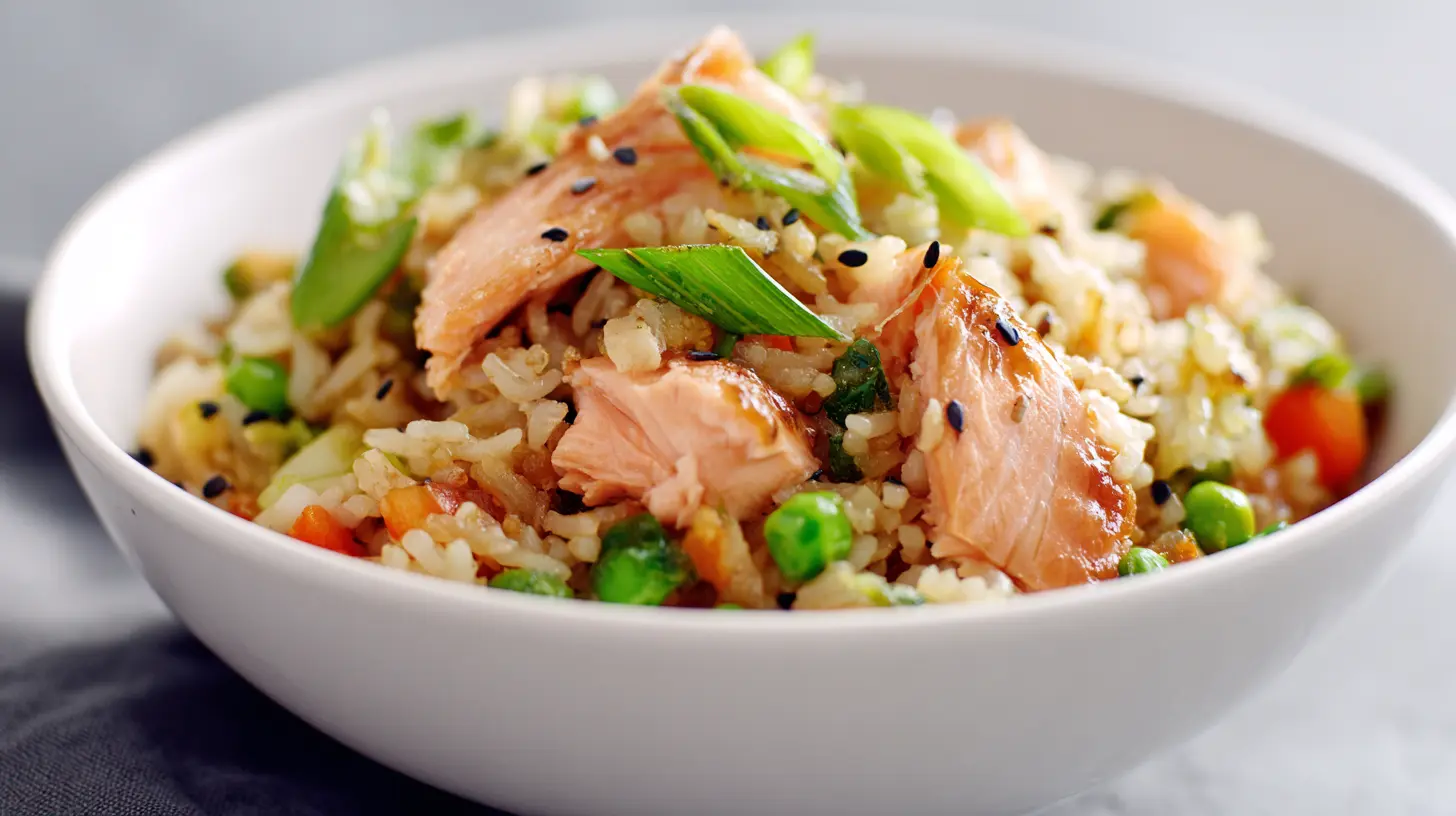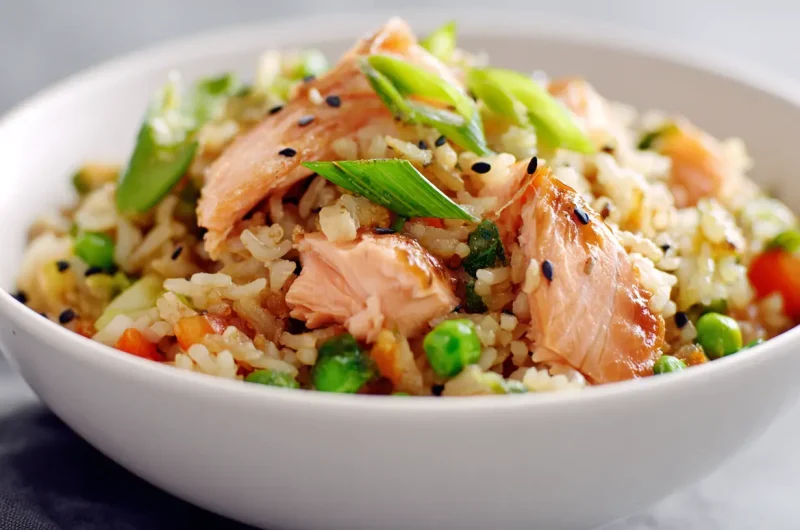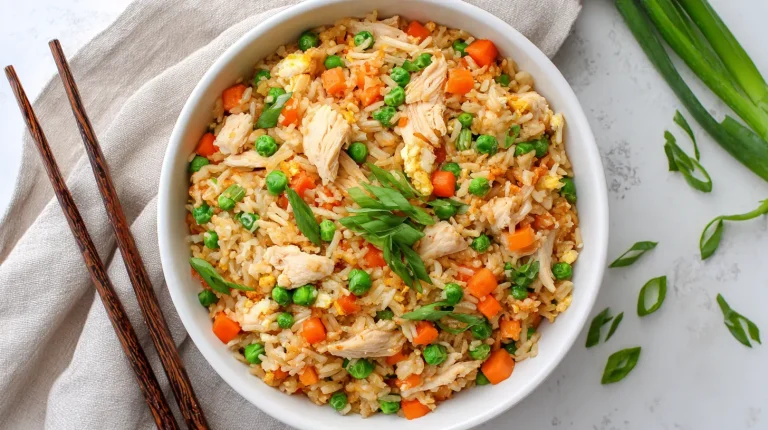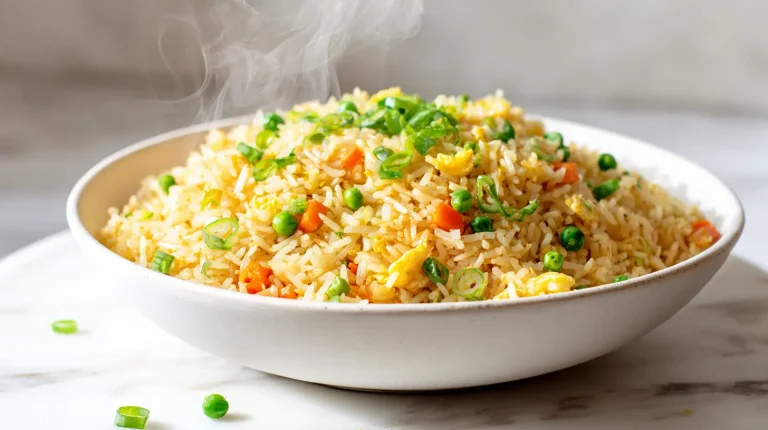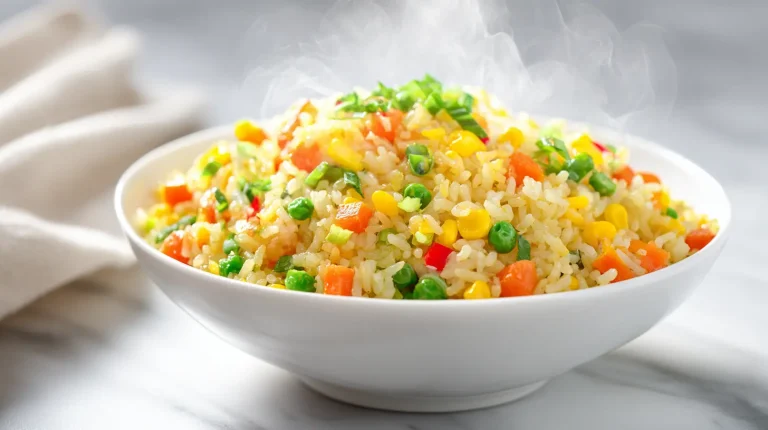Salmon Fried Rice Recipe – Easy Fried Rice With Salmon
Introduction to Salmon Fried Rice
Salmon fried rice is a delightful twist on classic fried rice, combining the rich, buttery flavor of salmon with the comforting, umami-packed taste of stir-fried rice. Unlike standard fried rice, this dish balances protein, vegetables, and rice in a single pan, making it both flavorful and satisfying. The salmon adds a delicate, slightly sweet taste that pairs beautifully with soy sauce, sesame oil, and fresh aromatics. Whether you are craving a quick weeknight meal or a restaurant-style dinner at home, salmon fried rice elevates a simple rice dish into something special that everyone will love.
The beauty of this recipe lies in its versatility. You can make it with fresh salmon, smoked salmon, or even leftover cooked salmon. Every version offers a different texture and depth of flavor, giving you the freedom to adapt based on what you have on hand. A perfectly cooked salmon fried rice has tender flakes of salmon, slightly crisp rice grains, and a harmony of vegetables and seasonings that create a satisfying, balanced bite every time.
Salmon fried rice is not only delicious but also visually appealing. The vibrant orange of the salmon, the green of scallions or peas, and the golden hue of fried rice make it an attractive dish for the table. Served in a bowl or on a plate, it’s a feast for the senses, showing that simple ingredients can yield restaurant-quality results when treated with care and technique.
Why You’ll Love This Recipe
There are several reasons salmon fried rice stands out in the realm of home-cooked meals.

Preparation and Cooking Time
These times assume you are using pre-cooked or leftover rice, which is ideal for fried rice. Freshly cooked rice can be used but should be cooled to reduce moisture for the best texture.
Ingredients
Substitution Notes:

Step-by-Step Instructions

Step 1: Prepare the Salmon
For fresh salmon, season lightly with salt and black pepper. Heat 1 tablespoon of oil in a skillet over medium-high heat and sear the salmon 3–4 minutes per side until just cooked through. Remove from heat, allow to cool slightly, and flake into bite-sized pieces. If using smoked salmon, slice into strips or small chunks and set aside; no cooking is required.

Step 2: Cook the Aromatics
In a large wok or nonstick skillet, heat the remaining tablespoon of oil over medium-high heat. Add the diced onions and sauté until translucent. Stir in garlic and grated ginger, cooking for 30–45 seconds until fragrant. The aroma should be inviting and slightly sweet, a sign that the base flavor is building perfectly.

Step 3: Stir-Fry the Vegetables
Add the carrots and frozen peas to the pan. Stir-fry for 2–3 minutes until vegetables are tender but still retain a slight bite. Incorporating vegetables before the rice allows them to cook evenly and keeps them vibrant. Add the white parts of the scallions here for mild onion flavor.

Step 4: Scramble the Eggs
Push the vegetables to one side of the pan and pour the beaten eggs into the cleared space. Allow eggs to set for 15–20 seconds, then scramble gently. Once cooked, mix the eggs with the vegetables evenly. This technique ensures soft, fluffy eggs without overcooking.

Step 5: Add the Rice
Add the chilled, cooked rice to the pan, breaking up any clumps with a spatula. Stir-fry for 2–3 minutes, ensuring rice grains are evenly coated with oil and aromatics. A key to perfect fried rice is high heat and constant movement to achieve slightly crisp edges without burning.

Step 6: Season and Combine
Drizzle soy sauce and sesame oil over the rice, adding rice vinegar or chili sauce if desired. Stir well to distribute seasonings evenly. Fold in the flaked salmon gently, taking care not to break it down too much. Adjust salt and pepper to taste. Taste at this stage; fried rice should be well-seasoned but balanced.

Step 7: Finish with Scallions
Remove from heat and sprinkle the green parts of scallions on top for freshness and color. This final touch brightens the dish and adds a subtle onion aroma that complements the rich salmon. Serve immediately with lemon wedges on the side to enhance flavor.
How to Serve

Additional Tips
Recipe Variations
Freezing and Storage
Nutritional Information (Approximate per Serving)
Final Words
Salmon fried rice is more than just a meal; it’s an opportunity to bring restaurant-quality flavors into your home kitchen with minimal effort. Each component from the tender, flaky salmon to the perfectly stir-fried rice and vibrant vegetables comes together in a harmony of taste and texture that is both satisfying and memorable. By mastering this recipe, you’re not just learning how to make one dish; you’re building confidence in essential cooking techniques like stir-frying, seasoning in layers, and balancing flavors.
Cooking salmon fried rice at home allows you to control the quality of ingredients, experiment with creative variations, and adjust seasonings to suit your family’s taste. It’s a dish that rewards care and attention, and the result is a meal that feels indulgent yet wholesome. Whether you’re preparing it for a weeknight dinner, a casual lunch, or a small gathering, this recipe impresses without overwhelming you with complexity.
Ultimately, salmon fried rice is about enjoying the process as much as the result. Cooking at home offers a sense of pride, satisfaction, and joy that takeaway meals simply can’t replicate. Once you taste the rich, savory flavors of homemade salmon fried rice, you’ll understand why it’s become a favorite in both Japanese and home-cooked meals worldwide. With this recipe in your repertoire, you’re not just making a meal you’re creating a memorable dining experience that’s delicious, healthy, and uniquely yours.
FAQ’s
Salmon Fried Rice Recipe – Easy Fried Rice With Salmon
Course: Rice Recipes4
servings15
minutes15
minutes450
kcalIngredients
2 cups cooked jasmine rice (preferably day-old, chilled)
12 ounces salmon fillet (skin removed, fresh or smoked)
2 tablespoons vegetable oil or neutral cooking oil
1 small onion, finely diced
2 cloves garlic, minced
1 teaspoon fresh ginger, grated
1/2 cup frozen peas
1/2 cup diced carrots
3 scallions, sliced (green and white parts separated)
2 tablespoons soy sauce, low sodium preferred
1 tablespoon sesame oil
1 teaspoon rice vinegar (optional)
1 teaspoon chili sauce or Sriracha (optional for heat)
Salt and black pepper, to taste
2 eggs, lightly beaten
Lemon wedges for serving
Directions
- For fresh salmon, season lightly with salt and black pepper. Heat 1 tablespoon of oil in a skillet over medium-high heat and sear the salmon 3–4 minutes per side until just cooked through. Remove from heat, allow to cool slightly, and flake into bite-sized pieces. If using smoked salmon, slice into strips or small chunks and set aside; no cooking is required.
- In a large wok or nonstick skillet, heat the remaining tablespoon of oil over medium-high heat. Add the diced onions and sauté until translucent. Stir in garlic and grated ginger, cooking for 30–45 seconds until fragrant. The aroma should be inviting and slightly sweet, a sign that the base flavor is building perfectly.
- Add the carrots and frozen peas to the pan. Stir-fry for 2–3 minutes until vegetables are tender but still retain a slight bite. Incorporating vegetables before the rice allows them to cook evenly and keeps them vibrant. Add the white parts of the scallions here for mild onion flavor.
- Push the vegetables to one side of the pan and pour the beaten eggs into the cleared space. Allow eggs to set for 15–20 seconds, then scramble gently. Once cooked, mix the eggs with the vegetables evenly. This technique ensures soft, fluffy eggs without overcooking.
- Add the chilled, cooked rice to the pan, breaking up any clumps with a spatula. Stir-fry for 2–3 minutes, ensuring rice grains are evenly coated with oil and aromatics. A key to perfect fried rice is high heat and constant movement to achieve slightly crisp edges without burning.
- Drizzle soy sauce and sesame oil over the rice, adding rice vinegar or chili sauce if desired. Stir well to distribute seasonings evenly. Fold in the flaked salmon gently, taking care not to break it down too much. Adjust salt and pepper to taste. Taste at this stage; fried rice should be well-seasoned but balanced.
- Remove from heat and sprinkle the green parts of scallions on top for freshness and color. This final touch brightens the dish and adds a subtle onion aroma that complements the rich salmon. Serve immediately with lemon wedges on the side to enhance flavor.
Notes
- Use day-old rice whenever possible; it is drier and prevents mushy fried rice.
- Cut salmon into uniform pieces for even cooking and easy mixing.
- Keep the heat medium-high to high when stir-frying to achieve a slightly crisp texture.
- Avoid overcrowding the pan; it reduces heat and results in steaming rather than frying.
- Taste as you go; adjusting seasoning in layers ensures depth of flavor.
- Flake the salmon gently after cooking to maintain tender texture.

